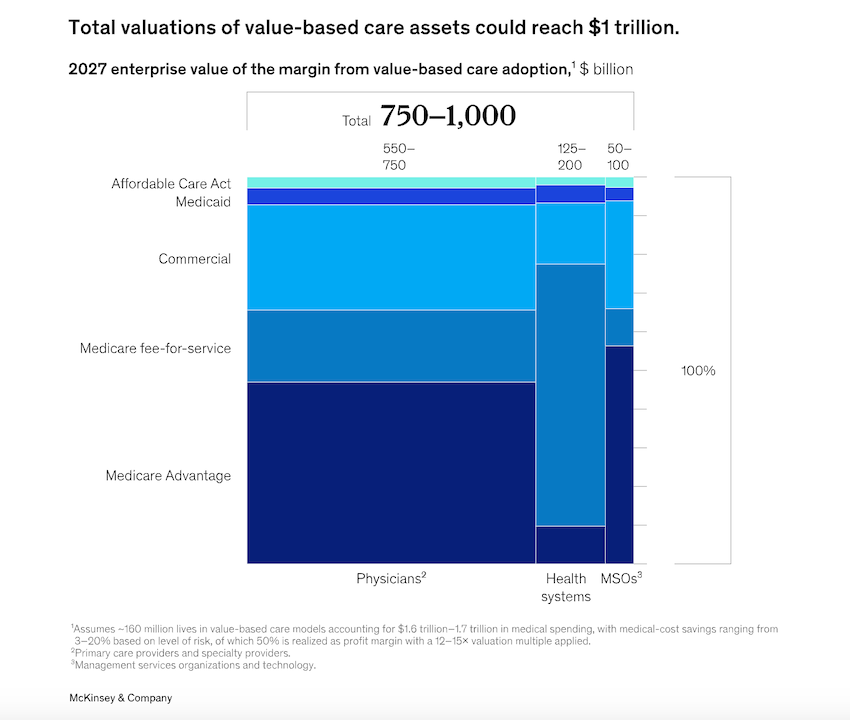Over the last few years the healthcare industry has shifted its focus from a fee-for-service model to value-based care, which spotlights favorable outcomes and patient satisfaction over the amount of services rendered. This transition has been driven by a growing awareness of the need to both reduce costs and improve overall patient health, as well as a desire to increase accountability among healthcare providers.
One of the key enablers of this transition has been technology. Advancements in digital health tools have made it easier for providers to measure quality patient metrics, track patient outcomes, and quickly identify areas for improvement. In addition, new technologies such as telemedicine and remote patient monitoring have made it possible to deliver care outside of the traditional healthcare setting, which allows for more proactive and preventive care.
In this blog post, we will take a look at value based care technology and the various ways in which technology is helping to advance it. From improving patient engagement to enhancing care coordination and reducing costs, we will examine the impact of digital health tools and explore the opportunities and challenges of implementing these technologies in a value-based care model.
We will cover the following topics
- What is value-based care?
- How does value-based care work?
- The role technology plays in vbc healthcare
- The future of value-based care
What is value-based care
Value-based care (or can be seen as vbc healthcare) is a healthcare delivery model that places the spotlight on the overall value of care provided to patients, instead of the quantity of services provided. In a value-based care model, providers are rewarded for achieving positive patient outcomes and improving the overall health of their patient population, instead of simply providing a greater quantity of services.
This model is a step away from the traditional fee-for-service model, which propels providers to perform more procedures and order more tests, regardless of whether they are necessary or effective. This can also be referred to as the business of healthcare. On the other hand, value-based care is designed to reward providers for providing high-quality, cost-effective care that improves the health and wellbeing of their patients.
There are a number of key principles that are tied to value-based care, including those such as: a focus on patient-centered care, preventive care, and the coordination of care. Providers in a value-based care model are encouraged to work together to provide coordinated care that addresses every aspect of a patient's health, from their physical and mental health to social and environmental factors as well.
All in all, the goal of value-based care is to improve the quality of care provided to patients while at the same time reducing healthcare costs. By rewarding providers for achieving positive patient outcomes and encouraging them to work together to provide coordinated care, value-based care has great potential to improve the health of individuals and communities while also reducing the financial burden of healthcare.
How does value-based care work?
So as we saw above, vbc healthcare is a healthcare delivery model that focuses on attaining positive patient outcomes and improving the overall value of the care that is provided to patients, rather than just providing more services or procedures. There are several different value-based care models that are used in the healthcare industry today. Some of the most common ones are:
- Accountable care organization (ACO): In this model, groups of healthcare providers work together to coordinate care for a specific population of patients. Providers are responsible for managing the overall health of their patients, and are rewarded financially for achieving positive patient outcomes while also reducing healthcare costs.
- Pay-for-performance (P4P): This model incentivizes healthcare providers to achieve specific quality measures and outcomes, such as reducing hospital readmissions or improving patient satisfaction scores. Providers are rewarded financially for meeting these goals.
- Patient-centered medical home (PCMH): This model focuses on providing comprehensive, coordinated care to patients through a team-based approach. Providers are responsible for addressing all aspects of a patient's health, from their physical and mental health to their social and environmental factors.
- Bundled payment: This model involves paying healthcare providers a single payment for all services related to a specific episode of care, such as a joint replacement surgery. Providers are incentivized to work together to provide high-quality, cost-effective care that results in positive patient outcomes.
These are just a few examples of the value-based care models that are currently being used in the healthcare industry. Each model has its own unique approach to incentivizing providers to deliver high-quality, cost-effective care that improves patient outcomes. By implementing these models, healthcare organizations can improve the overall quality of care provided to patients while also reducing healthcare costs. The Centers for Medicare & Medicaid Services has a value-based program that rewards providers with incentive payments for the quality of care they give to people with Medicare.
The rol technology plays in vbc healthcare
Technology is playing a crucial role in enabling value-based care. Ranging from value based care software to increasing the efficiency of already existing tools. Here are some ways in which technology is aiding in this shift:
Electronic Health Records (EHRs): These are digital records of a patient's medical history, including test results, diagnoses, treatments, as well as medications. EHRs allow healthcare providers to access a patient's complete medical history in one place, which allows them to make more informed decisions about treatment options. They also enable care coordination between different providers and reduce duplication of tests and procedures.
Population Health Management (PHM): This is the process of analyzing and improving the health outcomes of a particular population by improving the coordination of care as well as patient engagement. PHM tools use data analytics and machine learning algorithms to identify patients that are high risk and intervene early to prevent complications. For example, a PHM tool might identify patients with chronic conditions who are at risk of hospitalization and connect them with a care team that can provide preventive care. This can be an example of value based care technology.
Telemedicine: Telemedicine is the use of technology to provide healthcare services remotely. It allows patients to receive care from their homes, which goes hand in hand with improving access to care and reducing costs. It can also facilitate care coordination between different providers and reduce the need for in-person visits.
Wearable devices: Wearable devices, such as fitness trackers and smartwatches, can provide patients with data about their health. This data can allow them to make more informed decisions about their health, such as adjusting their diet or exercise routine. Wearable devices also help enable remote patient monitoring, which can aid providers in identifying early warning signs of complications and overall improving patient outcomes. Technology allows patients to become more active participants in their own care, providing them with tools to track their health and communicate with their providers.
Clinical decision support (CDS) systems: These systems are software tools that provide healthcare providers with real-time information about treatment options. CDS systems help providers make more informed decisions about treatments, such as choosing medications that are more effective and less costly. This is a great example of value based care software.
The future of value-based care
The future of value-based care is most likely going to involve further expansion and fine-tuning of this model. One of the trends that is likely to grow is the use of technology to support value-based care initiatives. As we stated above, electronic health records and other digital tools can help healthcare providers track patient outcomes and identify areas for the improvement of care. Data analytics and predictive modeling can also be used to identify patients who are at risk for chronic conditions, allowing providers to intervene early and prevent more serious health problems. As we can see technology is one of value based care’s biggest allies in this paradigm shift we’re trying to make and the future of value based care technology is bright.
Another trend that is likely to shape the future of value-based care is the increasing focus on population health management. This approach involves looking at the health of entire populations and identifying ways to improve outcomes for everyone, instead of just focusing on individual patients. Population health management initiatives may involve preventive care measures, such as health screenings and education programs, as well as efforts to improve the social determinants of health, such as access to healthy food and safe housing.
Growth in the valued-based care field has increased from approximately $500 billion in enterprise value today and could be on track to reach $1 trillion as it matures.

Overall, the future of value-based care is most likely going to involve a continued shift toward more patient-centered, data-driven, and cost-effective healthcare delivery models. As providers, payers, as well as policymakers continue to experiment with new approaches and technologies, it is likely that value-based care will become an increasingly important part of the healthcare landscape.
In conclusion, technology and value based care software plays a crucial role in enabling this healthcare model. By providing healthcare providers with real-time data, facilitating care coordination, and improving access to care, technology is helping to improve patient outcomes and reduce healthcare costs. If you're still wondering how does value based care work you can check out CMS value based programs descriptions.
We’re always looking to do our part and partner with companies on a mission to enable value-based care and improve people’s lives.




